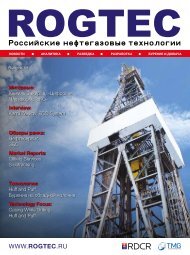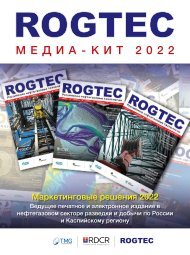ROGTEC Issue 62
Russian Oil & Gas Magazine
Russian Oil & Gas Magazine
Create successful ePaper yourself
Turn your PDF publications into a flip-book with our unique Google optimized e-Paper software.
БУРЕНИЕ
01
Инструменты в
офисе
Tools in the Office
02 03 04 05
Инструменты на
объектах
Tools used at
Workover Facilities
Инструменты
мониторинга
Monitoring Tools
Система
управления и
коммуникаций
The System of
Management and
Communications
Развитие
компетенций и
лидерства
Development of
Competencies and
Leadership
Роман Козлов, менеджер проекта, менеджер по
бурению MOL GROUP Russia
Реализуя проект по повышению эффективности
ТКРС, мы не хотели изобретать велосипед. В бурении
у нас прекрасно работали инструменты повышения
эффективности: планирование скважины, график
глубина-день, блок-схемы операций, планерки с
вахтами. Мы хотели адаптировать эти инструменты под
операции ремонта скважин.
В результате мы определили порядок работы и
внедрили ежемесячное планирование КРС (по
аналогии планирования скважины в бурении),
детальный план-график ремонта скважины на
основании норм времени (по аналогии с графиком
глубина-день), и многие другие инструменты.
Не все это внедрение проходило гладко. Так, поначалу
мы считали, что для ТКРС быстрое и качественное
составление план-графика ремонта на каждую
скважину будет сложной задачей. Однако, достаточно
быстро мы это решили с помощью несложной таблицы
в Excel, и теперь при начале каждого ремонта мастер
получает очень точный план работ, рассчитанный
строго по нормативам. На основании этого плана он
определяет с бригадой операции на каждую смену, по
завершении ремонта предоставляет бригаде обратную
связь, подводит итоги. Мы же получаем важную
статистику о продолжительности отдельных операций
ремонта и сведения о причинах отклонений.
Мотивация бригад
Одной из ключевых проблем в ТКРС являлась
низкая мотивация работников бригад подрядчика.
У рядовых сотрудников была невысокая зарплата,
As a result, we defined the procedures and
implemented monthly workover planning (similar to
the drilling plan), a detailed workover schedule based
on standard time norms (similar to the day depth
schedule), and many other tools.
Not all the implementation went smoothly. At first we
thought we would need quickly produce a high-quality
workover schedule per well and that this would be a
difficult task to complete. However, quite swiftly we
solved this with the help of a simple Excel spreadsheet,
and now at the beginning of each repair the foreman gets
an accurate plan of work, calculated strictly according to
standards. Based on this plan, he determines with the
crew the operations for each shift, after the repair they
provide the team with feedback and a summary. We also
get important statistics about the duration of individual
workover operations and information about the causes of
any deviations in the plan.
Crew Motivation
One of the key problems during well service operations
was the low motivation of the contractor’s crews.
Ordinary employees had low wages, there was no
connection between work performance and pay. One
of the first tasks of the project was to fix this.
Oleg Kondratiev, the head of the contractor’s workover
team, had already worked out the principles of crew
motivation. With the support of BaiTex management, the
contractor was persuaded to implement a transparent
and results-based incentive system. At first, no one
was sure that this system, even if it were launched,
would work for more than a month or two. Result: since
January 2020, the system has worked like clockwork, it
now has the trust of all the employees.
70
ROGTEC
www.rogtecmagazine.com















